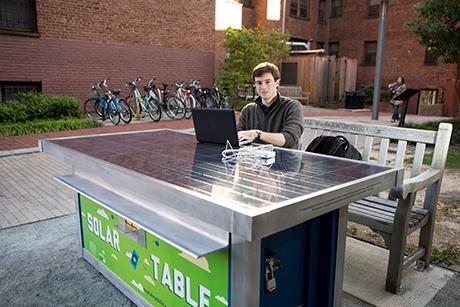The Square 80 Plaza, the Law Clinic and the Walter G. Ross Hall at the George Washington University recently received accolades for green designs, highlighting the university’s continued commitment to sustainability.
Located between 21 and 22 streets and F and G streets, the Square 80 Plaza is one of 30 projects across the U.S. to receive a certification by the Sustainable SITES Initiative.
The U.S. Green Building Council awarded LEED Gold certifications to the Law Clinic, located at 650 20th St. NW, and to the Ross Hall, located at 2300 I St., for sustainable features incorporated into the recently completed fifth and sixth floor renovation.
“We are proud of the recognition GW’s sustainable designs continue to earn,” Division of Operations Director of Planning & Design Review Nancy Giammatteo said. “That the university has been acknowledged for three such diverse projects is evidence of our commitment to being a model of sustainability across campus.”
The SITES program is a collaborative effort between the American Society of Landscape Architects, the Lady Bird Johnson Wildflower Center at the University of Texas at Austin and the United States Botanic Garden that evaluates projects nationwide using a rating system for sustainable design.
Square 80, also known as the Green Plaza, was completed in April 2010 as a part of the 2007 Foggy Bottom Campus Plan. The space, which recently received a one star designation from SITES, replaced an urban space parking lot with a pedestrian network, tree grove, and outdoor classroom for the Sustainable Landscape program.
The Green Plaza produces a diverse range of sustainable rewards due to the biofiltration planters, native plant material, pervious pavers, and cisterns and rain barrels which capture overflow water and roof runoff for irrigation and use in the sculptural water feature.
The design, which targets 100 percent retention of stormwater, uses a rain garden and bioswale filtration to manage stormwater.
The plaza is also the home of the solar table, a student-designed solar-powered table used by the campus community to charge laptops, cell phones and other devices. The project, funded through GW Center for Student Engagement, the Student Association and the Residence Hall Association is representative of the campus-wide commitment to sustainability.
With the recent LEED Gold certification for the Law Clinic and Ross Hall, seven university buildings have met this standard, including South Hall Residence, the West Hall Residence and Campus Life Center, the Charles E. Smith Center, the Lafayette Hall and the Ames Hall.
“Support for green infrastructure has a positive ripple effect on our academic mission,” Director of the Office of Sustainability and Senior Advisor to the Sustainability Initiative Meghan Chapple said. “A greener campus can inspire research, conversations and learning for a more sustainable world.”
The Research Center for Neglected Diseases of Poverty and the Center for Basic Research for the Cure and Prevention of HIV/AIDS are located on the renovated fifth and sixth floor of Ross Hall. The renovation achieved a LEED Commercial Interiors (CI) designation at the gold level.
The laboratory renovation was funded through a $15 million grant awarded to the School of Medicine and Health Sciences by the National Institute of Health.
The space includes energy efficient lighting with an Energy Star rating according to guidelines outlined by the Environmental Protection Agency. Additionally, 100 percent of the lighting fixtures have occupancy sensors for responsible use of electricity and the HVAC Systems are optimized for energy efficiency.
The Law Clinic features low flow fixtures and occupancy sensors. Other sustainable features of the building include an efficient Variable Refrigerant Flow(VRF) HVAC system, a reflective white roof, an improved thermal envelope for the building exterior, high efficiency glazing on windows to minimize heat loss and reduced interior lighting density.
Ms. Chapple said that the work of Ms. Giammatteo, Mr. Dent and Senior Associate Vice President for Operations Alicia Knight and their teams is making the vision of a thriving sustainable campus a reality.
“The recognition earned from these sustainability projects is beneficial for the university community and beyond,” Division of Operations Executive Director for Planning, Development and Construction David Dent said. “They are an example of the Division of Operations’ university-wide efforts to create a more sustainable campus.”





